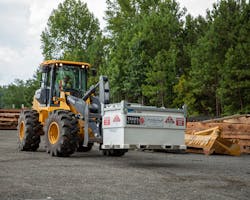Streamlining fuel delivery: Smart strategies for optimized routes
Navigating the complexities of fuel distribution requires constant route optimization. Successfully aligning delivery locations, fuel volumes, driver schedules, and customer timeframes is crucial for maximizing operational efficiency and minimizing costs.
Fuel distributors frequently encounter hurdles in route management stemming from personnel availability, fluctuating demand patterns, and the sheer geographic spread of their service areas. Predicting fuel consumption across diverse job sites presents a significant challenge. Moreover, staffing shortages and the extensive distances covered by drivers compound the difficulty of effective route planning.
However, strategic deployment of bulk fuel storage and monitoring technologies offers a solution for refining route logistics. Bulk fuel storage can significantly enhance labor utilization, bolster customer satisfaction, and drive down overall operational costs.
Reducing trips for seamless operations
Modular fuel storage tanks allow fuel distributors to make bulk fuel drops on jobsites of any size. This on-site bulk storage capability reduces the necessity for frequent trips, as customers maintain an accessible fuel supply precisely when and where they require it. By decreasing the number of site visits, distributors gain enhanced scheduling flexibility without compromising revenue. Freed-up time from one delivery can be readily allocated to another.
Double-walled cube-shaped tanks, like those available from Western Global, also reduce initial installation time—distributors don’t have to worry about digging a containment berm like they would with a traditional round tank. They’re also easier to move on site; look for tanks with corner brackets and four-way forklift pockets on a galvanized frame to ensure effortless moveability. Less time spent installing and moving your tank means more time to reach additional jobsites.
Fuel trailers offer another form of flexibility. With specific fuel trailer models, like the Western Global MultiCube, a CDL or hazmat endorsement is not needed to transport fuel. In the face of current CDL shortages, this capability can bridge labor gaps, ensuring comprehensive route coverage.
Planning with real-time data
Beyond the time and cost savings realized through bulk diesel storage, integrating tank monitoring or telematics systems further optimizes route efficiency. Certain fuel tank solutions come equipped with pre-installed telematics, providing real-time data on fuel levels and GPS location. The savings from proactive fuel monitoring can be substantial—up to thousands per week.
Advanced fuel management systems offer even more granular control over consumption and usage. These systems provide detailed insights into fuel levels and consumption rates, alongside data on who dispensed fuel and when (often via RFID technology). Such solutions are particularly beneficial for organizations managing a large inventory of tanks, requiring precise tracking of fuel consumption and sales transactions.
Best practices for fuel monitoring
To maximize the value of a fuel-monitoring telematics system, consider these key practices:
- Set proactive alerts: Most telematics platforms allow users to configure fuel level alerts, notifying distributors when tank levels reach predefined thresholds. These thresholds can be customized to align with individual operational preferences (e.g., alerts at 50% or 20% capacity).
- Analyze the data: While reactive alerts are useful, the true potential of telematics lies in proactive analysis. By studying historical fuel consumption data, distributors can predict future needs, enabling more efficient route scheduling. For long-term on-site tank deployments, analyzing several weeks of usage data allows for accurate forecasting of refill requirements. This proactive approach not only streamlines route planning and ensures driver availability but also enhances customer satisfaction through timely service.
- Prioritize system maintenance: Like all job site equipment, telematics and fuel monitoring hardware require regular maintenance to ensure optimal performance. Consistent health checks prevent missed alerts or inaccurate data transmission, which could lead to unexpected customer downtime if they run out of fuel.
- Train the team: Comprehensive training for all personnel interacting with the telematics software is essential. Users must understand how to navigate the system and interpret the data effectively.
Driving efficiency and reducing headaches
By strategically incorporating bulk fuel storage tanks and intelligent fuel monitoring solutions, fuel distributors can reduce the challenges of route planning. More logistical efficiency translates to better management of labor resources, reduction or elimination of overtime expenses, and lower internal fuel costs—all while maintaining high levels of customer satisfaction and unlocking potential avenues for revenue growth.
About the Author

Jesus Rodriguez
Jesus Rodriguez is the regional product manager for small tanks accessories at Western Global.


